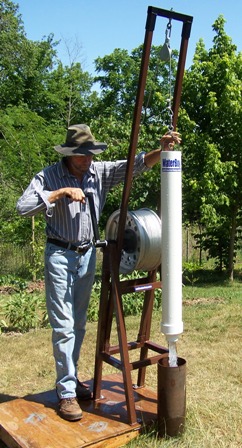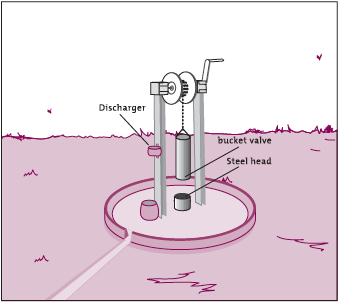Bucket pump
| |
|
|
|
|
|
|
|
|
The bucket pump is mainly used in drilled wells. It consists of a windlass over a 125 mm PVC tube, down which a narrow bucket with a valve in the base is lowered into the water on a chain. When the bucket hits the water, the valve opens and the water flows in. When the bucket is raised, the valve closes and the water is retained in the bucket. To release the water, the pump operator rests the bucket on a water discharger, which opens the valve in the base. The windlass bearings are made of wood.
Suitable conditions
Range of depth: 0–15 m.
Number of people served: up to 200.
Yield: Relatively low and depends on well depth.
Trademarks: Developed by Blair Research Laboratory.
Area of use: Zimbabwe and elsewhere.
Construction, operations and maintenance

To operate a bucket pump, rotate the handle of the windlass and let the bucket passthrough the steel head. Both adults and children can operate the pump. Preventive maintenance consists of lubricating the wooden bearings of the windlass, checking the nuts and bolts, and checking that the valve is functioning. The pump and its environment should be kept clean, and the well should be disinfected regularly. Minor repairs consist of replacing the valve washers and repairing links in the chain.
Broken links in the chain can be repaired with steel wire. If the chain has fallen into the tubewell it can be hooked out with a long piece of wire. A major requirement is repairing the bottom of the bucket, which can be done locally by a tinsmith or blacksmith. At some stage, the chain, the bucket or the bearings of the windlass will need to be replaced. A local craftsman may be needed to repair or replace the windlass system. Usually, village committees are formed to drill or dig the well, and install the pump. The committee can also organize maintenance activities and collect fees for repairs. After the pump is installed, simple lessons in O&M should be given, followed by monitoring, and occasional assistance by external agencies.
Potential problems
— loose valve parts;
— broken chain;
— stones thrown in the well by children;
— low discharge rates;
— contamination, especially with communal wells;
— chlorine for disinfecting the well may not be locally available.

Manuals, videos and links
- Dr. Costantino Faillace. RE-ASSESSMENT IN THE SUMMER OF 1997 REGARDING THE PERFORMANCE OF A BUCKET PUMP - A SIMPLE WATER LIFTING DEVICE SUITABLE FOR SMALL RURAL VILLAGES. Ciampino (Rome) – Italy.
Acknowledgements
- Brikke, François, and Bredero, Maarten. Linking technology choice with operation and maintenance in the context of community water supply and sanitation: A reference document for planners and project staff. World Health Organization and IRC Water and Sanitation Centre. Geneva, Switzerland 2003.
